
Dalai Lama is a title given by the Tibetan people to the foremost spiritual leader of the Gelug or "Yellow Hat" school of Tibetan Buddhism, the newest and most dominant of the four major schools of Tibetan Buddhism. The 14th and current Dalai Lama is Tenzin Gyatso, who lives as a refugee in India. The Dalai Lama is also considered to be the successor in a line of tulkus who are believed to be incarnations of Avalokiteśvara, the Bodhisattva of Compassion.

Sonam Gyatso was the first to be named Dalai Lama, although the title was retrospectively given to his two predecessors.
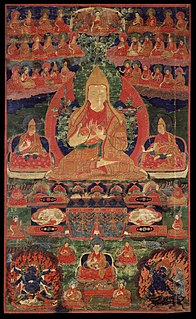
The Gelug is the newest of the four major schools of Tibetan Buddhism. It was founded by Je Tsongkhapa (1357–1419), a Tibetan philosopher, tantric yogi and lama and further expanded and developed by his disciples.
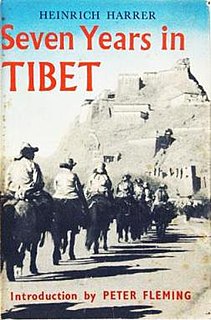
Seven Years in Tibet: My Life Before, During and After is an autobiographical travel book written by Austrian mountaineer and Nazi SS sergeant Heinrich Harrer based on his real life experiences in Tibet between 1944 and 1951 during the Second World War and the interim period before the Communist Chinese People's Liberation Army invaded Tibet in 1950.

The Panchen Lama is a tulku of the Gelug school of Tibetan Buddhism. Panchen Lama is one of the most important figures in the Gelug tradition, with its spiritual authority second only to Dalai Lama. Along with the council of high lamas, he is in charge of seeking out the next Dalai Lama. Panchen is a portmanteau of Pandita and Chenpo, meaning "great scholar".

Robert Alexander Farrar Thurman is an American Buddhist author and academic who has written, edited, and translated several books on Tibetan Buddhism. He was the Je Tsongkhapa Professor of Indo-Tibetan Buddhist Studies at Columbia University, before retiring in June 2019. This was the first endowed chair in Buddhist Studies in the West. He also is the co-founder and president of the Tibet House US New York. He translated the Vimalakirti Sutra from the Tibetan Kanjur into English. He is the father of actress Uma Thurman.
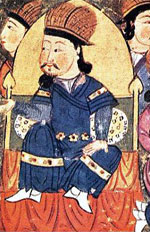
Altan Khan of the Tümed, whose given name was Anda, was the leader of the Tümed Mongols and de facto ruler of the Right Wing, or western tribes, of the Mongols. He was the grandson of Dayan Khan (1464–1543), a descendant of Kublai Khan (1215–1294), who had managed to unite a tribal league between the Khalkha Mongols in the north and the Chahars (Tsakhars) to the south. His name means "Golden Khan" in the Mongolian language.
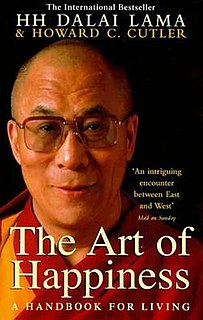
The Art of Happiness is a book by the 14th Dalai Lama and Howard Cutler, a psychiatrist who posed questions to the Dalai Lama. Cutler quotes the Dalai Lama at length, providing context and describing some details of the settings in which the interviews took place, as well as adding his own reflections on issues raised.
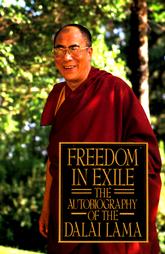
Freedom in Exile: The Autobiography of the Dalai Lama is the second autobiography of the 14th Dalai Lama, released in 1991. The Dalai Lama's first autobiography, My Land and My People, was published in 1962, a few years after he reestablished himself in India and before he became an international celebrity. He regards both of the autobiographies as authentic and re-issued My Land and My People in 1997 to coincide with the release of the film Kundun.
Lamrim is a Tibetan Buddhist textual form for presenting the stages in the complete path to enlightenment as taught by Buddha. In Tibetan Buddhist history there have been many different versions of lamrim, presented by different teachers of the Nyingma, Kagyu and Gelug schools. However, all versions of the lamrim are elaborations of Atiśa's 11th-century root text A Lamp for the Path to Enlightenment (Bodhipathapradīpa).

Ngawang Lobsang Gyatso was the 5th Dalai Lama and the first Dalai Lama to wield effective temporal and spiritual power over all Tibet. He is often referred to simply as the Great Fifth, being a key religious and temporal leader of Tibetan Buddhism and Tibet. Gyatso is credited with unifying all Tibet under the Ganden Phodrang after a Mongol military intervention which ended a protracted era of civil wars. As an independent head of state, he established relations with the Qing empire and other regional countries and also met early European explorers. Gyatso also wrote 24 volumes' worth of scholarly and religious works on a wide range of subjects.

Losang Chö kyi Gyaltsen (1570–1662) was the fourth Panchen Lama of the Gelug school of Tibetan Buddhism and the first to be accorded this title during his lifetime.

Glenn H. Mullin is a Tibetologist, Buddhist writer, translator of classical Tibetan literature and teacher of Tantric Buddhist meditation.

Kumbum Monastery, also called Ta'er Temple, is a Tibetan gompa in Lusar, Huangzhong County, Xining, Qinghai, China. It was founded in 1583 in a narrow valley close to the village of Lusar in the historical Tibetan region of Amdo. Its superior monastery is Drepung Monastery, immediately to the west of Lhasa. It is ranked in importance as second only to Lhasa.

Wang Lixiong is a Chinese writer and scholar, best known for his political prophecy fiction, Yellow Peril, and for his writings on Tibet and provocative analysis of China's western region of Xinjiang.

The Kashag, was the governing council of Tibet during the rule of the Qing dynasty and post-Qing period until the 1950s. It was created in 1721, and set by Qianlong Emperor in 1751 for the Ganden Phodrang in the 13-Article Ordinance for the More Effective Governing of Tibet. In that year the Tibetan government was reorganized after the riots in Lhasa of the previous year. The civil administration was represented by Council (Kashag) after the post of Desi was abolished by the Qing imperial court. The Qing imperial court wanted the 7th Dalai Lama to hold both religious and administrative rule, while strengthening the position of the High Commissioners.

The 14th Dalai Lama, known as Gyalwa Rinpoche to the Tibetan people, is the current Dalai Lama. He is the highest spiritual leader and former head of state of Tibet. Born on 6 July 1935, or in the Tibetan calendar, in the Wood-Pig Year, 5th month, 5th day. He is considered a living Bodhisattva; specifically, an emanation of Avalokiteśvara in Sanskrit and Chenrezig in Tibetan. He is also the leader and an ordained monk of the Gelug school, the newest school of Tibetan Buddhism, formally headed by the Ganden Tripa. The central government of Tibet, the Ganden Phodrang, invested the Dalai Lama with temporal duties until his exile in 1959. On 29 April 1959, the Dalai Lama established the independent Tibetan government in exile in the north Indian hill station of Mussoorie, which then moved in May 1960 to Dharamshala, where he resides. He retired as political head in 2011 to make way for a democratic government, the Central Tibetan Administration.

The Ganden Phodrang or Ganden Podrang was the Tibetan government that was established by the 5th Dalai Lama in 1642. Lhasa became the capital of Tibet early in this period, with all temporal power having been conferred to the 5th Dalai Lama by the Oirat lord Güshi Khan in Shigatse. The Ganden Phodrang accepted the Qing emperor as overlord in the 17th century, and the Qing became increasingly active in governing Tibet starting in the early 18th century. After the fall of the Qing empire in 1912, the Ganden Phodrang government lasted until the 1950s, when Tibet was incorporated into the People's Republic of China (PRC). During most of the time from the early Qing period until the end of Ganden Phodrang rule, a governing council known as the Kashag was the highest authority in the Ganden Phodrang administration.
My Spiritual Autobiography is a book published in 2009, compiled by Sofia Stril-Rever from speeches and interviews of the 14th Dalai Lama, ISBN 9781846042423.

The Memorandum on Genuine Autonomy for the Tibetan People provides a framework for the governance of Tibet within the People's Republic of China (PRC). In 2008 a group led by the Dalai Lama presented the memorandum to China. Beijing invited Dalai Lama's delegation to talk about his middle path, which promoted autonomy rather than full independence. Beijing rejected the proposal vehemently, claiming that it was as good as giving independence to Tibet. Following the presentation of the Memorandum, talks between China and Dalai Lama's envoys that had started in 2002 broke down. The last communication was in January 2010.



















